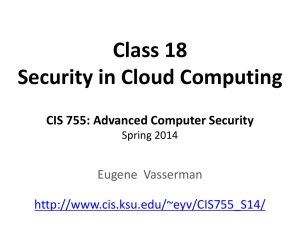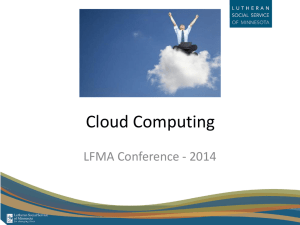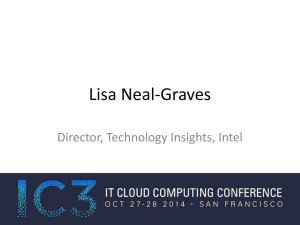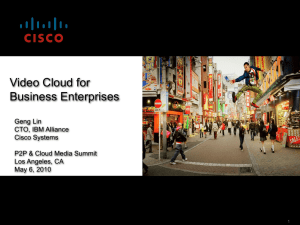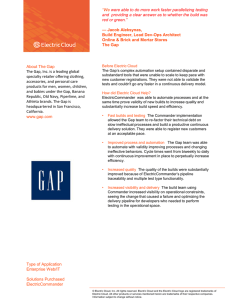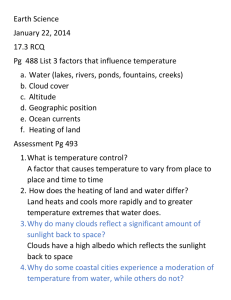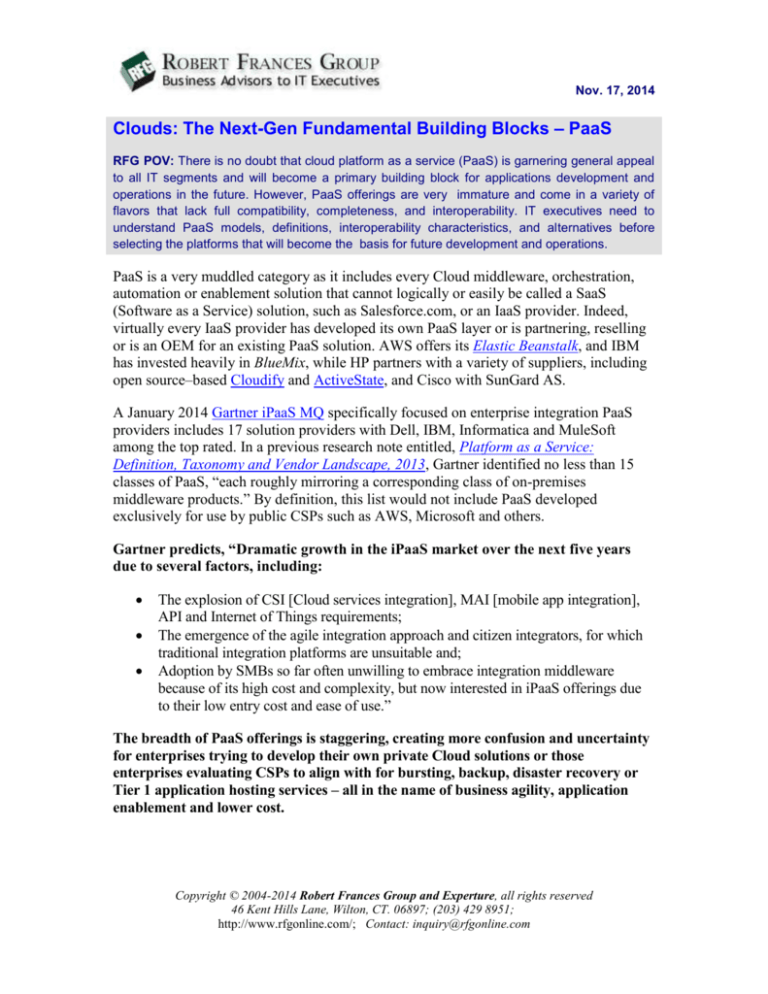
Nov. 17, 2014
Clouds: The Next-Gen Fundamental Building Blocks – PaaS
RFG POV: There is no doubt that cloud platform as a service (PaaS) is garnering general appeal
to all IT segments and will become a primary building block for applications development and
operations in the future. However, PaaS offerings are very immature and come in a variety of
flavors that lack full compatibility, completeness, and interoperability. IT executives need to
understand PaaS models, definitions, interoperability characteristics, and alternatives before
selecting the platforms that will become the basis for future development and operations.
PaaS is a very muddled category as it includes every Cloud middleware, orchestration,
automation or enablement solution that cannot logically or easily be called a SaaS
(Software as a Service) solution, such as Salesforce.com, or an IaaS provider. Indeed,
virtually every IaaS provider has developed its own PaaS layer or is partnering, reselling
or is an OEM for an existing PaaS solution. AWS offers its Elastic Beanstalk, and IBM
has invested heavily in BlueMix, while HP partners with a variety of suppliers, including
open source–based Cloudify and ActiveState, and Cisco with SunGard AS.
A January 2014 Gartner iPaaS MQ specifically focused on enterprise integration PaaS
providers includes 17 solution providers with Dell, IBM, Informatica and MuleSoft
among the top rated. In a previous research note entitled, Platform as a Service:
Definition, Taxonomy and Vendor Landscape, 2013, Gartner identified no less than 15
classes of PaaS, “each roughly mirroring a corresponding class of on-premises
middleware products.” By definition, this list would not include PaaS developed
exclusively for use by public CSPs such as AWS, Microsoft and others.
Gartner predicts, “Dramatic growth in the iPaaS market over the next five years
due to several factors, including:
The explosion of CSI [Cloud services integration], MAI [mobile app integration],
API and Internet of Things requirements;
The emergence of the agile integration approach and citizen integrators, for which
traditional integration platforms are unsuitable and;
Adoption by SMBs so far often unwilling to embrace integration middleware
because of its high cost and complexity, but now interested in iPaaS offerings due
to their low entry cost and ease of use.”
The breadth of PaaS offerings is staggering, creating more confusion and uncertainty
for enterprises trying to develop their own private Cloud solutions or those
enterprises evaluating CSPs to align with for bursting, backup, disaster recovery or
Tier 1 application hosting services – all in the name of business agility, application
enablement and lower cost.
Copyright © 2004-2014 Robert Frances Group and Experture, all rights reserved
46 Kent Hills Lane, Wilton, CT. 06897; (203) 429 8951;
http://www.rfgonline.com/; Contact: inquiry@rfgonline.com
Nov. 17, 2014
PaaS – Platform as a Service Providers
As with the other categories, the following vendors are a representative example of PaaS
solution providers, not an exhaustive list.
ActiveState is the parent company for Stackato, based on Cloud Foundry, which “makes it
easy to develop, deploy, migrate, scale, manage, and monitor applications on any Cloud,”
available in Enterprise, Micro Cloud, and Sandbox editions. HP Helion began an OEM
relationship with ActiveState in late 2012 including Stackato as part of its PaaS portfolio
for “building applications for creating private PaaS using any language on any stack on any
Cloud. Additionally, enterprise IT can achieve new levels of data security, reduce time to
market, save money, ensure compliance, and gain greater control over the Cloud.” Ease
of use and agility is achieved through narrowing the gap between development, test and
production.
Citrix CloudPlatform offers “simple, turn-key Cloud orchestration. CloudPlatform is the
only Cloud orchestration platform that enables you to quickly and efficiently build a futureproofed Cloud. It is a turn-key solution based on an open and flexible architecture that is
designed to run every application workload at scale and with simplicity.” In July 2011,
Citrix acquired CloudStack developer Cloud.com, now available through an Apache
Software open source license. Considered one of the early Cloud orchestration innovators,
Citrix has morphed Cloud.com into CloudPlatform and claims more than 2,500 Cloud
providers as users, including AWS. CloudPlatform also leverages standard AWS APIs and
a rich partner ecosystem as well as offering its own Turnkey IaaS.
Copyright © 2004-2014 Robert Frances Group and Experture, all rights reserved
46 Kent Hills Lane, Wilton, CT. 06897; (203) 429 8951;
http://www.rfgonline.com/; Contact: inquiry@rfgonline.com
Nov. 17, 2014
Docker is an “open platform for developers and sysadmins to build, ship and run
distributed applications. Consisting of Docker Engine, a portable, lightweight runtime
and packaging tool, and Docker Hub, a Cloud service for sharing applications and
automating workflows, Docker enables apps to be quickly assembled from components
and eliminates the friction between development, QA, and production environments. As a
result, IT can ship faster and run the same app, unchanged, on laptops, data center VMs,
and any Cloud.” Whether on-premise bare metal or data center VMs or public Clouds,
workload deployment is less constrained by infrastructure technology and is instead
driven by business priorities and policies. The Docker Engine container comprises just
the application and its dependencies.
Copyright © 2004-2014 Robert Frances Group and Experture, all rights reserved
46 Kent Hills Lane, Wilton, CT. 06897; (203) 429 8951;
http://www.rfgonline.com/; Contact: inquiry@rfgonline.com
Nov. 17, 2014
GigaSpaces Technologies provides software middleware for deployment, management
and scaling of mission-critical applications on Cloud environments through two main
product lines, XAP In-Memory Computing and Cloudify. “Hundreds of Tier-1
organizations worldwide are leveraging GigaSpaces’ technology to enhance IT efficiency
and performance, from top financial firms, e-commerce companies, online gaming
providers, healthcare organizations and telecom carriers.” GigaSpaces recently released
its 3.0 version of Cloudify with an open source community version along with a muchimproved premium edition that includes an enhanced UI, plug-ins for standard tools,
advanced blueprints, elastic caching and Replication as a Service, making it “even easier
for enterprises to automate and manage apps and take Cloud orchestration to the next
level.”
Informatica Cloud’s integration platform-as-a-service (iPaaS) allows enterprises to
“extend the capabilities of Informatica Cloud through a variety of development tools,
including a REST API and a Java-powered Cloud Connector SDK. Its multi-tenant iPaaS
offers benefits for enterprises, including breaking down the walls of data, process and
service integration by having a common set of artifacts; increasing collaboration between
integration and application developers, as well as ETL and EAI architects; and rapidly
connecting to homegrown, proprietary, or legacy systems through REST or SOAP web
services, as well as emerging data standards such as JSON or OData.” Informatica iPaaS
also offers independent software vendors and system integrators to quickly onboard
customer apps and cut the time and cost of integration projects.
Copyright © 2004-2014 Robert Frances Group and Experture, all rights reserved
46 Kent Hills Lane, Wilton, CT. 06897; (203) 429 8951;
http://www.rfgonline.com/; Contact: inquiry@rfgonline.com
Nov. 17, 2014
Jelastic offers “Platform-as-Infrastructure, the integration of Infrastructure-as-a-Service
and Platform-as-a-Service, delivering a scalable, manageable and highly available
Cloud.” DevOps can deliver a “private or hybrid enterprise Cloud that drives down costs
and increases agility. Provide your developers with an enterprise-class private PaaS that
enables rapid application development and deployment without coding to proprietary
APIs.” Jelastic automates
horizontal and vertical
scaling and provides denser
packing of applications
hosted by CSPs, while also
facilitating dynamic sizing
and live migration of
containers such as Docker.
Jelastic “simplifies” Private
Cloud by providing an
infrastructure that is “easy to
deploy and simple to
manage the entire enterprise
stack and can install on ‘bare
metal’ servers.”
Copyright © 2004-2014 Robert Frances Group and Experture, all rights reserved
46 Kent Hills Lane, Wilton, CT. 06897; (203) 429 8951;
http://www.rfgonline.com/; Contact: inquiry@rfgonline.com
Nov. 17, 2014
Mirantis is the “number one pure-play OpenStack solutions provider, the most
progressive, flexible, open distribution of OpenStack, combining the latest innovations
from the open source community with the testing and reliability customers expect. More
customers rely on Mirantis than any other company for the software, services, training
and support needed for running OpenStack Cloud.” Mirantis is the only pure-play
OpenStack contributor in the top five companies contributing open source software to
OpenStack and supports many Global 1,000 companies such as AT&T, Cisco WebEx,
Comcast, Dell, The Gap, NASA, NTT Docomo and PayPal to build and deploy
production-grade OpenStack. Mirantis OpenStack is a “zero lock-in distro that makes
deploying Cloud easier, more flexible and more reliable,” while OpenStack Express is an
“on-demand Private-Cloud-as-a-Service” that allows users to deploy workloads
“immediately.”
MuleSoft provides the most widely used integration platform for connecting any
application, data source or API, whether in the Cloud or on-premises. With Anypoint™
Platform, MuleSoft delivers a complete integration experience built on proven open
source technology, eliminating the pain and cost of point-to-point integration. Anypoint
Platform includes CloudHub™ iPaaS, Mule ESB™ and a unified solution for API
management, design and publishing. “CloudHub is the fastest way to integrate SaaS
applications reliably and securely. The platform of choice for enterprise integration,
CloudHub offers global availability and 99.99% uptime. Compliance with the highest
Copyright © 2004-2014 Robert Frances Group and Experture, all rights reserved
46 Kent Hills Lane, Wilton, CT. 06897; (203) 429 8951;
http://www.rfgonline.com/; Contact: inquiry@rfgonline.com
Nov. 17, 2014
security standards ensures integrations are protected wherever they run.” MuleSoft has
more than 170 enterprise customers.
Managed Cloud Services Providers
Many of the above-mentioned IaaS solution providers also offer Managed Cloud
Services, including IBM and SunGard Availability Services. Telcos such as AT&T, NTT
and Verizon also have viable offerings in this space. This space is also crowded with
hundreds of service providers of every ilk. The primary reason for this is MCSPs make
the transition to the Cloud much easier for most organizations.
The two examples below are MCSPs that leverage other provider networks/datacenters
and specialize – although not exclusively – within specific application areas (e.g.
Avanade for Microsoft applications) or within specific industries (e.g. DataPipe in
financial services).
Avanade “Private Cloud solution is built on the latest Microsoft technologies, including
Windows Server 2012, System Center 2012 and Avanade’s own Cloud Services Manager
software. These technologies enable IT to improve productivity, optimize operations,
lower costs, tighten security and reduce your environmental footprint. Avanade also
offers scalable, infrastructure-managed services that can help you rapidly cut costs. We
offer a comprehensive selection of managed services including Service Desk coverage,
Workplace Services, Data Center Services, Network Services and Security Services.” A
Copyright © 2004-2014 Robert Frances Group and Experture, all rights reserved
46 Kent Hills Lane, Wilton, CT. 06897; (203) 429 8951;
http://www.rfgonline.com/; Contact: inquiry@rfgonline.com
Nov. 17, 2014
joint venture between Accenture and Microsoft, Avanade seeks to accelerate the business
value of Private Cloud with tailored managed services while providing clients with a
flexible, agile business approach.
Datapipe offers a single provider solution for managing and securing mission-critical IT
services, including Cloud computing, infrastructure as a service, platform as a service,
colocation and data centers. “Datapipe delivers those services from the world’s most
influential technical and financial markets, including New York metro; Ashburn, VA;
Silicon Valley; Iceland; London; Tel Aviv; Hong Kong; Shanghai and Singapore.
Datapipe Managed Cloud for Amazon Web Services (MAWS) is a unique offering that
combines the flexibility, scalability and power of Amazon’s world-leading Cloud
platform with Datapipe’s awardwinning support and managed services
to power hybrid Cloud solutions with
Datapipe High performance Oracle,
SQL and MySQL database clusters
delivered as a service over a direct
connection between Amazon and
Datapipe networks.” According to
Netcraft, Datapipe’s impressive
connect time, 16ms, is evidence of the
benefits of their globally disperse
hosting platform.” Datapipe offers a
Copyright © 2004-2014 Robert Frances Group and Experture, all rights reserved
46 Kent Hills Lane, Wilton, CT. 06897; (203) 429 8951;
http://www.rfgonline.com/; Contact: inquiry@rfgonline.com
Nov. 17, 2014
comprehensive suite of enterprise-grade managed security and compliance solutions.
Conclusion
The PaaS market is still very nascent but standards and taxonomies are slowly coming
together. Nonetheless, there are an innumerable number of options that must be sorted
though so that the right sets are selected. To do that applications and operations
executives and architects will need to work together to make sure there is concurrence on
requirements and standards.
RFG POV: There is a need for IT executives to find ways to become more innovative, cut
costs, and accelerate application and analytics speed-to-market and a movement now to
implementing cloud platforms is one such step. Multiple PaaS platforms and micro
services will need to be assembled in order to build the middleware platform(s) that will
support are parts of application life cycle management – from development on PCs to
post-production. IT executives and data architects should carefully evaluate what
platforms and micro services are needed and which ones provide the compatibility and
interoperability characteristics required so that agility and component reuse are
maximized while costs and resources are minimized.
Additional relevant research is available. Interested readers should contact Client Services to
arrange further discussion or interview with Mr. Gary MacFadden, Principal Research Analyst.
Copyright © 2004-2014 Robert Frances Group and Experture, all rights reserved
46 Kent Hills Lane, Wilton, CT. 06897; (203) 429 8951;
http://www.rfgonline.com/; Contact: inquiry@rfgonline.com

